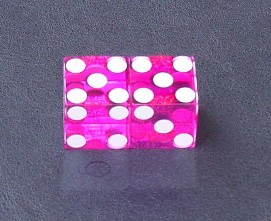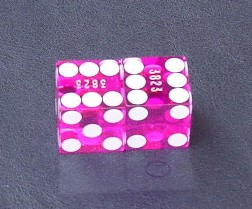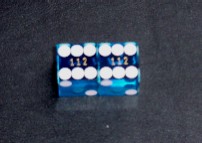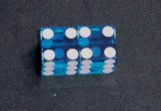My Dice Sets
The dice have no memory…

Crossed Hard 10 Set:
The fives are on both horizontal surfaces, the four is on one vertical surface, the three is on the other vertical surface. The six and one are on the axis.
Pros and Cons:
This is an excellent set for the come out (4 possible theoretical sevens, but no theoretical Yo’s or craps). You’ll have a higher propensity of come out hard ways with this set so if you feel so inclined to bet the hardways, make sure you call them on.
Important: Remember, ALL SETS are based on the axis and not the horizontal and vertical faces, so the crossed hard 10 set can be arranged in a variety of other combinations based on the same six / one axis. Example: Five and two on the horizontal surfaces, four and three on vertical surfaces is on same axis.

Crossed Six Set:
The sixes are on both horizontal surfaces, only the pips (dots) on one die should run left to right and the pips on the other should run up and down. The five should be on the vertical surface of the six with the pips running left to right, the four should be on the vertical surface of the six with the pips running up and down. The 4/3 will be on the axis of the left die, the 2/5 is on the axis of the right.
Pros and Cons:
It is an excellent set for after point is established (2 possible theoretical sevens). You’ll role a good number of inside numbers and also find yourself hitting the same numbers over and over again. If I throw a 12 or a Yo, I’ll generally put some money on them for the next roll.

Flying “V” Set:
The threes will be on the horizontal surfaces, but when you hold the dice together, the threes should form a “V”. The two or five should be on the vertical of the left die, the one or six should be on the vertical of the right die. The one/six and the two/five should be on the axis.
Pros and Cons:
Again it is an excellent set for after the point is established (2 possible theoretical sevens). Excellent for place bets on the inside numbers.

The Hard 4 Set:
The twos are on both horizontal surfaces. Facing the shooter is a three on the left vertical surface while the one is on the right vertical surface. The axis is made up of the six / one on the left die while the three / four is the axis of the right die.
Pros and Cons:
This set targets the outside numbers 4,5,9,10 (each with 2 of 16 possibilities) while maintaining only 2 theoretical sevens. The 6 and 8 too have four total possibilities while the 11 and 3 have one possibility each. No 2 or 12 are expected.

Straight Sixes Set:
The sixes are on both horizontal surfaces, the twos or fives are on the vertical. When the dice are held together, the three and four are on the axis.
Pros and Cons:
Good for come out (4 possible sevens), good for horns and hard ways. Bet cautiously if the stickman is presenting the dice to other shooters in this manner after the come out.

Hard 8 Set:
The fours are on both horizontal surfaces, the sixes or ones are on the vertical. The five and two are on the axis.
Pros and Cons:
Possible for come out (4 possible sevens), good for the outside numbers. Poor C and E and hard ways.
Remember, you are shooting on a theoretical axis which still has undesirable outcomes. Since the dice are cubes and the back wall is beveled, you will not have success with every throw. But, even with occasional success you will find that you have indeed altered the frequency table, which in turn will increase your profits over time. How will you achieve success?
Practice!

